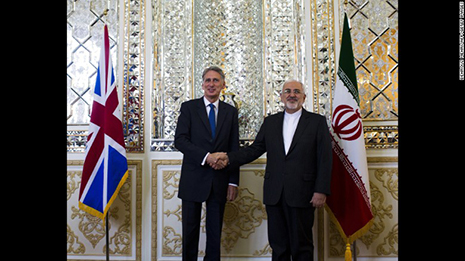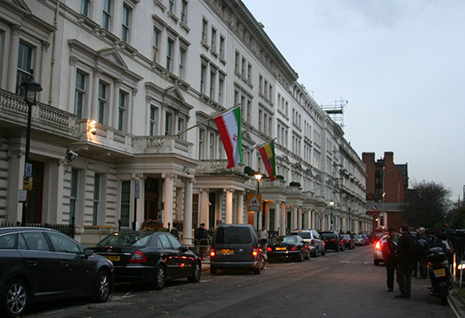Hammond watched the union flag being raised in the embassy compound in central Tehran for the first time since it was stormed and ransacked by protesters in 2011.
Reflecting the cautious nature of the relationship with a long, troubled history, the Iranian government sent a relatively junior official, Abolghasem Delphi, the head of the western European department at the foreign ministry. He made no public comments.
But Hammond is due to meet his Iranian counterpart, Mohammad Javad Zarif, later on Sunday, and the president, Hassan Rouhani, on Monday morning. Also on Sunday he was expected to visit Iran’s petroleum ministry, accompanied by a small group of British business figures.
“We will not always agree but as confidence and trust grows, there should be no limit to what over time we can achieve together and no limit to our ability to discuss together the challenges we mutually face,” Hammond said.
Later inside the embassy, the foreign secretary described the current relationship as “cordial”, but he told the Guardian it remained within the “confines that will always be imposed by the fact that we have fundamentally different views about some issues.”
“We are exploring our way forward,” he said. “The important thing is to distinguish between agreement to have a civilised dialogue and agreement to agree on everything. We clearly don’t agree on everything. We will have still have substantial differences of view about many areas of policy and regional politics. But the fact is we will now have a structure and a mechanism where we will be able to speak to each other regularly and in a relatively low-key way about these issues.”
Hammond pointed to “the scale of the lack of trust on both sides”.
“Superficially there is a willingness on both sides to engage,” the foreign secretary said. “But there is also an awareness of a legacy of lack of trust and you can only rebuild trust through experience.”
He was speaking in the drawing room of the embassy residence, which is still marked by the signs of that distrust, left by the mob invasion in 2011. The doors are still scrawled with red felt-pen graffiti in Farsi saying “death to England”.

The 140-year-old embassy is still awaiting restoration specialists to cover it up with historically appropriate paint. The graffiti has been left in place as a reminder of the precarious nature of the relationship.
Hammond is the first British foreign secretary to visit Iran since Jack Straw 12 years ago. The bilateral relationship has been volatile since the 1979 Islamic revolution, with diplomatic relations being cut three times, immediately after the revolution, then after Ayatollah Khomeini’s 1989 fatwa against the writer Salman Rushdie, and then again as a result of the 2011 invasion of the two British embassy compounds.
In the four years since that assault, the building has been looked after by Iranian caretakers. It has cost several million pounds to refurbish, a bill paid entirely by Britain. Hammond said Britain would file a compensation claim but would not let it get in the way of improving the relationship on other fronts.
Hammond also made clear that the UK would not be following the American example of opening its files on the British role in the 1953 coup that ousted the democratically elected Iranian leader Muhammad Mossadegh. There is substantial evidence of UK involvement and Mossadegh’s overthrow remains one of the principal roots of anti-British feeling in Iran today.
However, the foreign secretary said: “History is history, and both Britain and Iran have very long and complex histories and many things happened in the past that wouldn’t stand up to the scrutiny of present-day values and norms and laws, and I think we just have to draw a line under the past – events that happened before any of us were born – and focus on the future.”
The storming of the embassy was denounced by the Iranian government, and even mildly criticised by the supreme leader, Ali Khamenei, but although there were a few arrests on the day of the assault, there have been no prosecutions.
The mob that forced its way into the main embassy enclosure and a second British compound in north Tehran included many members of the Basij militia which is linked to Iran’s Islamic Revolutionary Guard Corps (IRGC). Some of the protesters held aloft pictures of Qassem Suleimani, the head of the IRGC external wing, the Quds force.
Even before 2011, the embassy’s ability to function normally had been severely constrained under the government of Mahmoud Ahmadinejad. Iranian staff in particular were constantly harassed, and any Iranians meeting British embassy staff would be subjected to interrogation by the security services.

The diplomats were ultimately forced to avoid contact with Iranians for fear of putting them at risk. The government of Rouhani, elected in 2013, was pledged that such harassment would stop.
There was no sign of the protests predicted by Iranian hardline media outside the reopening ceremony.
“We have clear assurances from the Iranian ministry of foreign affairs that our embassy will be allowed to operate normally without undue restrictions or harassment,” the foreign secretary said.
“We have a clear signal from the president of his underwriting of that assurance, but we also have to be realistic about the nature of Iranian society. There are different factions with different views and there will be people who are far less sanguine about the reestablishment of relations between Britain and Iran.
“Iran’s embassy in London will be opening this morning as well and I can confidently predict there will be groups in the UK who are opposed to that move. But our clear view is that we need to be talking to everybody who’s willing to talk to us, not only those with whom we agree on everything.”
Long before the events of 2011, the British embassy in Tehran was a flashpoint.
The building work alone – which took five years – was complicated by the architect’s decision to transport the roof and other materials, such as glass, from the UK.
Part of the roof was lost at sea in 1871, and two caravans of 367 camels transporting other materials were variously robbed by bandits and held to ransom by excise officials. Finally, a ship carrying glass and joinery caught fire at the port city of Bushehr. The building was finished in June 1876.
In 1906, the embassy played a key role in the uprising which led to the establishment of a parliament in Iran, when well over 10,000 Tehran people took refuge in the compound.
The Foreign Office history notes that Churchill, Stalin and Roosevelt met in Tehran for the first time to discuss the progress of the war and the future of Europe, even though the bulk of the meetings were at the Soviet embassy.
More about:
















































